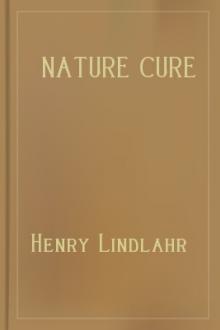Nature Cure, Henry Lindlahr [beautiful books to read .txt] 📗

- Author: Henry Lindlahr
- Performer: -
Book online «Nature Cure, Henry Lindlahr [beautiful books to read .txt] 📗». Author Henry Lindlahr
Thus the inspired Seer of the North draws a vivid picture of what we call healing crises in their relation to moral regeneration.
We cannot help recognizing the close agreement of physical and spiritual crises; this, again, demonstrates the continuity and exact correspondence of Natural Law on the different planes of being. [The Law of Hermes: As above, so below; as in the inner, so in the outer; as in the lesser, so in the greater.]
We of the Nature Cure school know that this great Law of Crises dominates the cure of chronic disease. Every case is another verification of it; in fact, every decided advance on the road to perfect health is marked by acute reactions.
The cure invariably proceeds through the darkness and chaos of the crises to the light and beauty of perfect health, periods of marked improvement alternating with acute eliminating activity (the “spiritual temptations” and “combats” of Swedenborg), until perfect regeneration has taken place.
Periodicity
In many forms of acute disease, crises develop with marked regularity and in well-defined periodicity. This phenomenon has been observed and described by many physicians.
It is not so well known, however, that in the cure of chronic diseases also, crises develop in accordance with certain laws of periodicity.
Periodicity is governed by the Septimal Law or Law of Sevens, which seems to be the basic law governing the vibratory activities of the planetary universe.
The harmonics of heat, light, sound, electricity, magnetism and of atomic structure and arrangement run in scales of seven.
The Law of Sevens governs the days of the week, the phases of the moon and the menstrual periods of the woman. Every observing physician is aware of its influence on feverish, nervous and psychic diseases.
The Law of Sevens dominates the life of individuals and of nations and of everything that lives and has periods of birth, growth, fruitage and decline.
Over two thousand years ago Pythagoras and Hippocrates distinctly recognized and proclaimed the Law of Crises in its bearing on the cure of chronic diseases. They taught that alternating, well-defined periods of improvement and of crises were determined and governed by the law of periodicity and by the law of numbers (the Septimal Law).
The following quotations are taken from the Encyclopedia Britannica, Vol. XV, p. 800:
“But this artistic completeness was closely connected with ‘the third cardinal virtue’ of Hippocratic medicine—the clear recognition of disease as being equally with life a process governed by what we should now call natural laws, which could be known by observation and which indicated the spontaneous and normal direction of recovery, by following which alone could the physician succeed.
“Another Hippocratic doctrine, the influence of which is not even yet exhausted, is that of the healing power of Nature. Not that Hippocrates taught, as he was afterwards reproached with teaching, that Nature is sufficient for the cure of diseases; for he held strongly the efficacy of art. But he recognized, at least in acute diseases, a natural process which the humours went through—being first of all crude, then passing through coction or digestion, and finally being expelled by resolution or crisis through one of the natural channels of the body. The duty of the physician was to foresee these changes, ‘to assist or not to hinder them,’ so that ‘the sick man might conquer the disease with the help of the physician.’ The times at which crises were to be expected were naturally looked for with anxiety; and it was a cardinal point in the Hippocratic system to foretell them with precision. Hippocrates, influenced as is thought by the Pythagorean doctrine of numbers, taught that they were to be expected on days fixed by certain numerical rules, in some cases on odd, in others on even numbers—the celebrated doctrine of ‘critical days.’ It follows from what has been said that prognosis, or the art of foretelling the course and event of the disease, was a strong point with the Hippocratic physicians. In this perhaps they have never been excelled. Diagnosis, or recognition of the disease, must have been necessarily imperfect, when no scientific nosology, or system of disease* existed, and the knowledge of anatomy was quite inadequate to allow of a precise determination of the seat of disease; but symptoms were no doubt observed and interpreted skilfully. The pulse is not spoken of in any of the works now attributed to Hippocrates himself, though it is mentioned in other works of the collection.”
*The author of this article in the Encyclopedia Britannica does not see that it is the modern [then as now] orthodox “scientific nosology, or system of disease” which obscures the simplicity and precision of the Hippocratic philosophy of disease and cure.
“In the treatment of disease, the Hippocratic school attached great importance to diet, the variations necessary in different diseases being minutely defined. In chronic cases diet, exercises and natural methods were chiefly relied upon.”
These wonderful truths, with other wisdom of the ancients, were lost in the spiritual darkness of the Middle Ages. Modern medicine looks upon these claims and teachings of the Hippocratic School as “superstition without any foundation in fact.” However, the great sages of antiquity, drawing upon a source of ancient wisdom, deeply hidden from the self-satisfied scribes and wise men of the schools, after all, proclaimed the truth.
Every case of chronic disease properly treated by natural methods proves the reality and stability of the Law of Crises. It is therefore a standing wonder and surprise to one who knows, that this all-important and self-evident law is practically unknown to the disciples of the regular schools.
The Law of Sevens
In accordance with the Law of Periodicity, the sixth period in any seven periods is marked by reactions, changes, revolutions or crises. It is, therefore, looked upon by popular intuition as an unlucky period. Friday, the sixth day of the week, is regarded as an unlucky day; Friday is hangman’s day; according to tradition the Master, Jesus, was crucified on Friday.
Counting from the first sixth or Friday period in any given number of hours, days, weeks, months, years or groups of years, as the case may be, every succeeding seventh period is characterized by crises.
This explains why 13 is considered an unlucky number. It represents the second critical or Friday period.
However, there is really no cause for this superstitious fear of Friday and the number 13. It is due to a lack of understanding of Nature’s Laws. By intelligent cooperation with these laws we may turn the critical periods in our lives into healing crises and beneficial changes.
We should not fear the crises periods of the larger life and the changes in our outward circumstances which they may bring any more than we should fear crises in the physical body.
A thorough understanding of the nature and purpose of healing crises in acute and chronic diseases has taught me the nature and purpose of evil in general. It has made me understand more clearly the meaning of “Resist not Evil” and of the saying: “We are punished by our sins, not for our sins.” It has shown me that evil is not a punishment or a curse, but a necessary complement of good, that it is corrective and educational in its purposes, that it remains with us only as long as we need its salutary lessons.
The evil of physical disease is not due to accident or to the arbitrary rulings of a capricious Providence, nor is it always “error of mortal mind.” From the Nature Cure philosophy and its practical applications we have learned that, barring accidents and conditions or surroundings unfavorable to human life, it is caused in every instance by violations of the physical laws of our being. So the social, political and industrial evil of the larger life is brought about by violations of the law in the respective domains of life and action.
So long as transgressions of the physical laws of our being result in hereditary and acquired disease encumbrances, we must expect reactions which may become either disease crises or healing crises. Likewise, so long as ignorance, selfishness and self-indulgence continue to create evil in other domains of life, we must expect there also the occurrence of crises, of reaction and revolution. When knowledge, self-control and altruism become the sole motives of action, evil and the crises it necessitates will naturally disappear.
Therefore, we should not be afraid of changes and crises periods but cooperate with them clear-eyed and strong-willed. Then they will result in improvement and further growth.
Life is growth, and growth is change. The only death is stagnation. The loss of friends, home or fortune may seem for the time being an overwhelming calamity; but if met in the right spirit, such losses will prove stepping-stones to greater opportunity and higher achievement.
Many of our patients formerly looked upon their diseased condition as a great misfortune and an undeserved punishment; but since it brought them in contact with the Nature Cure philosophy and showed them the necessity of complying with the laws of their being, they now look upon the former evil as the greatest blessing in their lives, because it taught them how to become the masters of fate instead of remaining the plaything of Nature’s destructive forces.
Why should we fear even the greatest of all crises, physical death, when it, also, is only the gateway to a larger life, greater opportunities and more beautiful surroundings? Why should we mourn and grieve over the death of friends and relatives, when they have only emigrated to another, better country?
Suppose we ourselves had to enter upon the great journey today or tomorrow, shouldn’t we be glad to meet some of our friends on the other side and to be welcomed, advised and guided by them in the new surroundings?
Therefore we should not fear, nor endeavor to avoid the crises in any and all domains of life and action, but meet them and cooperate with them fearlessly and intelligently. They then will always make for greater opportunity and higher accomplishment.
The Law of Sevens Applied to Individual Life
Applied to the life of the individual, the Law of Periodicity manifests itself as follows:
Human life on the earth plane is divided into periods of seven years. The first seven years represent the period of infancy. With the next seven, the years of childhood, begins individual responsibility, the conscious discernment between right and wrong. The third group comprises the years of adolescence; the fourth marks the attainment of full growth. Nearly all civilized countries take cognizance of this fact by fixing the legal age at twenty-one.
The twenty-eighth year, the beginning of the fifth period, is another milestone along the road to development.
The sixth period, beginning at the age of thirty-five and ending at forty-two, is marked by reactions, changes and crises. It may, therefore, seem an unlucky period; but if we understand the law and comply with it, we shall be better and stronger in every way after we have passed this period.
During the seventh period, the effects of the sixth or crises period continue and adjust themselves. It is a period of reconstruction, of recuperation and rest, and thus the best preparation for a new cycle of sevens which begins with the fiftieth year.**
**Those who are interested in the Law of Periodicity as applied to life in general, will find much valuable information in a book entitled Periodicity by J. R. Buchanan, M.D.,





Comments (0)